Perfect soap making starts with essential oil ratios of 10-40 drops per 3.5 oz of soap base. You'll want to try proven formulas like the 34/33/33 blend of olive, coconut, and palm oils for a balanced foundation. For fragrance, start with classic single-note oils like lavender or lemon, then experiment with dual blends such as lavender-spearmint (5:3 ratio). Mastering these fundamental ratios and measurements will reveal endless possibilities for your natural soap creations.
Essential Oil Ratios for Soap Base Calculations
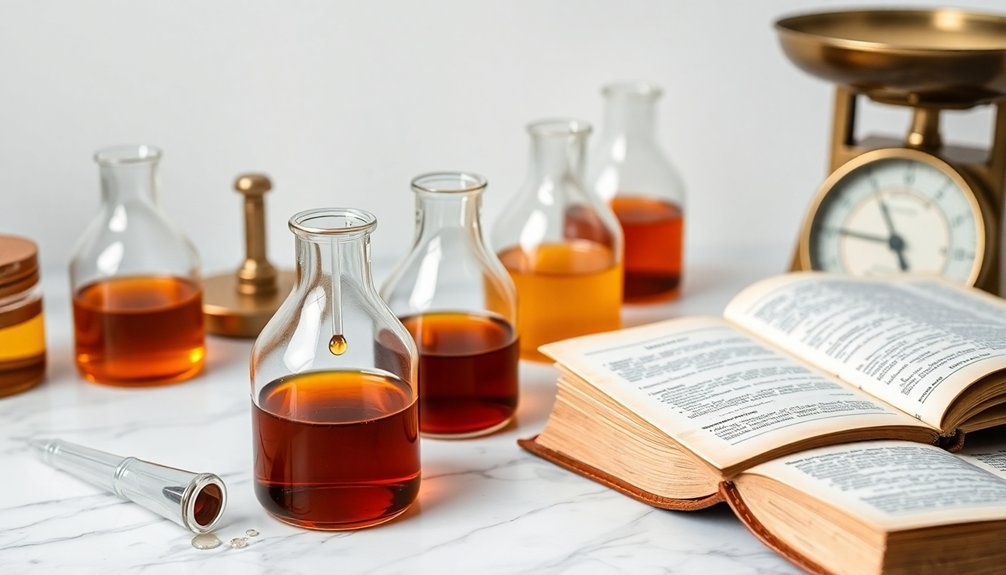
When creating your own soap blends, understanding essential oil ratios is crucial for achieving the perfect fragrance strength.
Mastering essential oil ratios in soap making determines whether your blend will have subtle notes or bold, lasting fragrances.
In cold process soap making, you'll need to calculate oil amounts based on your soap base weight. A reliable guideline is using 10-40 drops of essential oils per 3.5 oz (100g) of base.
For example, if you make soap with 7 oz (200g) of base, you'll first determine your total essential oil drops needed, then adjust your blend ratios accordingly.
Usage rates for essential oil blends can vary based on your desired scent intensity.
When following soap recipes, remember to add your essential oils at emulsion or light trace to preserve their aromatic properties. This timing guarantees your blend ratios remain effective and your fragrances stay true throughout the curing process.
Classic Single-Note and Dual Blend Combinations
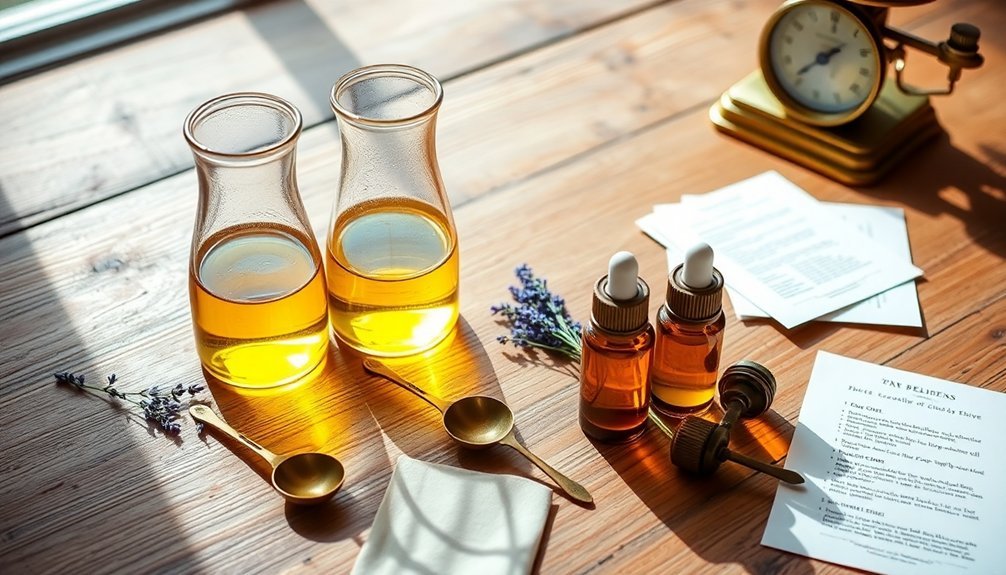
Starting with single-note essential oils like Lemon, Lavender, Vanilla, Spearmint, or Grapefruit can help you master the basics of soap scenting.
You'll find these individual oils offer distinct, uplifting aromas that stand beautifully on their own in your soap creations.
When you're ready to expand your fragrance portfolio, try proven duos like Lavender and Spearmint (5:3 ratio) or Lemon and Siberian Fir (1:1 ratio) for sophisticated, harmonious blends.
Single Oil Star Performers
Several single-note essential oils have earned their reputation as star performers in soap making, delivering powerful aromatherapy benefits with elegant simplicity.
You'll find that these essential oils stand perfectly on their own when you're crafting your soap formulations, requiring only precise measuring to achieve ideal results.
- Lavender: A versatile performer that creates a calming atmosphere while lending a classic floral note to your soap
- Lemon: Delivers an uplifting citrus punch that brightens both mood and complexion
- Eucalyptus: Offers powerful antiseptic properties paired with an invigorating scent
Remember to use your jeweler's scale when measuring essential oils, aiming for 10-40 drops per 3.5oz of soap base.
These single oil star performers prove that sometimes the simplest approach yields the most impressive results.
Pairing Oils For Success
Building upon our single oil success stories, the art of pairing fragrances opens up endless possibilities for your soap making journey.
When blending oils, you'll discover how complementary scents create unique scent profiles that elevate your natural soapmaking.
Start with proven combinations like Lavender and Spearmint in a 5:3 ratio for a calming experience, or try Lime and Orange in equal parts for an energizing blend.
For skin benefits and luxurious appeal, combine Lavender and Rose Geranium in a 1:1 ratio.
Remember to stay within safe ranges by using 10-40 drops of essential oils per 3.5oz of soap base to achieve a balanced scent.
These floral blends and citrus combinations aren't just about fragrance – they're about creating a personalized experience that transforms your basic soap into an aromatic masterpiece.
Advanced Multi-Oil Blend Formulations
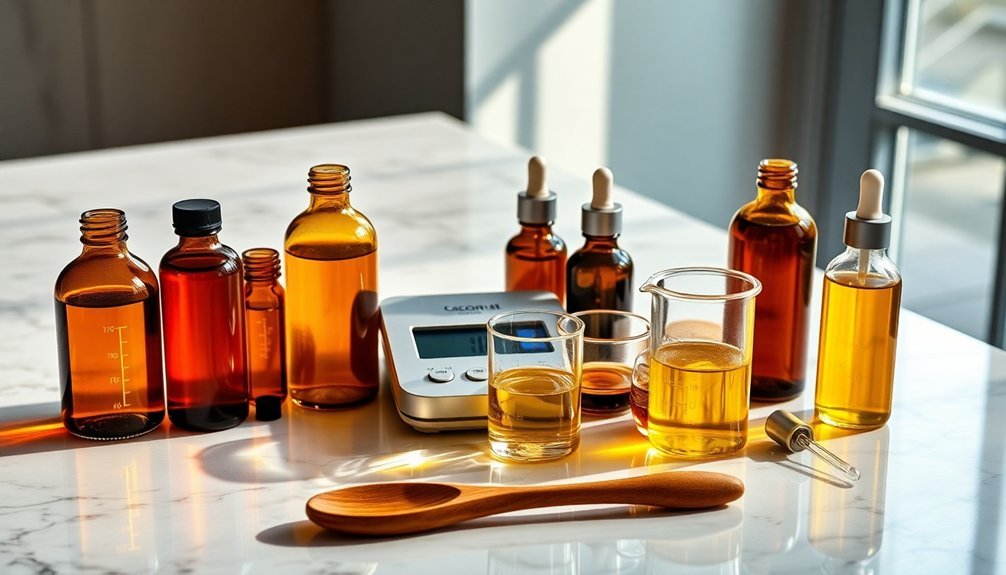
When crafting advanced multi-oil soaps, you'll want to start with a therapeutic base ratio of 30-40% hard oils combined with complementary liquid oils to achieve the best texture and hardness.
You can create complex scent layers by incorporating specialty oils like sweet almond or avocado at 10% of your formula, which won't just enhance fragrance but also boost moisturizing properties.
To guarantee safety in your multi-oil formulation, you must calculate each oil's specific saponification value for precise lye measurements, keeping in mind that values vary greatly between oils like coconut (0.183) and olive (0.134).
Therapeutic Blend Base Ratios
Mastering therapeutic soap blends requires understanding precise oil ratios that deliver both functionality and skin benefits.
You'll find success with proven formulations like the 34/33/33 blend of olive, coconut, and palm oils, which creates a balanced bar with ideal moisturizing and cleansing properties.
- Start with a classic 34/33/33 base ratio for well-rounded soap-making oils.
- Upgrade to a 30/30/30/10 formula by adding specialty oils like sweet almond.
- Fine-tune your superfat percentage while maintaining oil blend balance.
For enhanced therapeutic benefits, you can incorporate essential oils at 10-40 drops per 100g of base.
When working with multiple oils, make sure your hard oils provide lather while soft oils contribute moisture.
Complex Scent Layering Techniques
Crafting complex scent layers in soap requires strategic essential oil combinations and precise timing during the production process. You'll want to master the layering technique by adding essential oils at different stages, from emulsion to light trace, to create depth in your fragrance oils.
| Blend Type | Ratio | Oils Used |
|---|---|---|
| Soothing | 5:3 | Lavender:Spearmint |
| Citrus Invigorating | 2:2:2:1 | Lemon:Lime:Orange:Peppermint |
| Herbal Complex | 2:3:2:2 | Lemon:Lime:Lavender:Rosemary |
Calculate your essential oil blends based on 10-40 drops per 3.5 oz of soap base. For a revitalizing citrus scent profile, try combining lime and orange in equal parts. To create more complex scent combinations, experiment with herbal blends that incorporate multiple botanical notes. These multi-layered formulations will give your soaps a sophisticated aroma that appeals to diverse preferences.
Multi-Oil Safety Guidelines
Building upon our scent layering techniques, safety becomes the foundation of advanced multi-oil blend formulations. When creating multi-oil blends, you'll need to carefully calculate the total weight of essential oils while staying within maximum usage rates.
Using a jeweler's scale guarantees precise measurements, especially when working with multiple oils at varying concentrations.
- Calculate the combined weight of all essential oils to confirm you're not exceeding safety thresholds (like the 5% maximum for lavender in a 200g soap base)
- Consider the characteristics of each oil and how they might interact with your soap base
- Always test small batches before scaling up, as oil combinations can behave differently than individual oils
Remember to document your successful formulations and adjustments for consistent results in future batches.
Seasonal and Therapeutic Blend Proportions
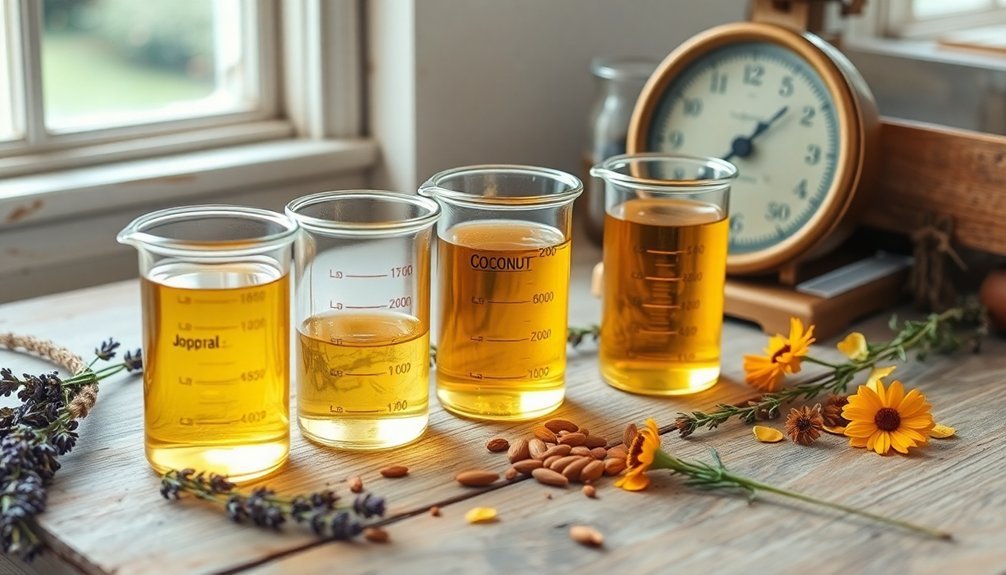
While selecting the right essential oil combinations is crucial, understanding their seasonal and therapeutic proportions can transform your soap from ordinary to extraordinary.
You'll find that blend proportions vary greatly based on your desired effects and the time of year.
For summer soap making, combine Lemon and Lime essential oils in equal parts for an energizing citrus blend.
When winter approaches, mix Lavender and Spearmint in a 5:3 ratio for a calming experience.
You can create a therapeutic blend using Patchouli and Roman Chamomile (2:3) that's perfect for stress relief.
For a versatile year-round option, try Lavender and Rose Geranium in equal measures.
If you're seeking skin-toning benefits, blend Lemon, Lavender, and Rosemary in a 2:3:2 ratio for a balanced, herbal seasonal soap.
Measuring and Mixing Techniques for Perfect Blends
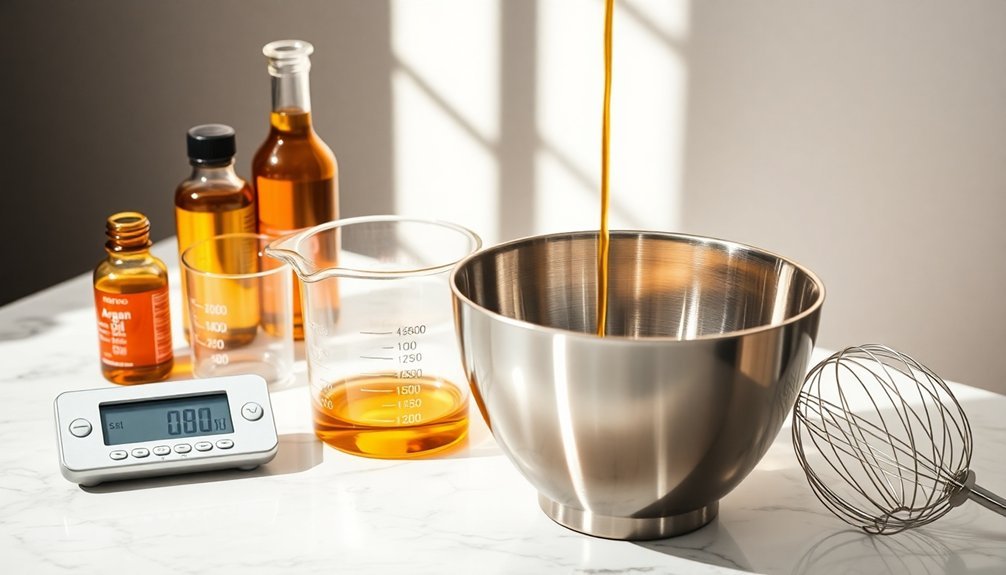
Now that you've mastered seasonal blending, precise measuring becomes your next key to success. When working with essential oils in your cold-process soap recipe, you'll need a jeweler's scale to guarantee accuracy and prevent waste.
Add your oils at emulsion or light trace to maximize scent retention and distribution throughout your soap base.
- Calculate your total essential oil drops using the 10-40 drops per 3.5oz rule, adjusting based on your lye calculator results.
- Divide your total drops according to your desired blend ratios.
- Stay within safe ranges for each oil to maintain both effectiveness and safety.
Remember to measure each essential oil separately before combining them. Your blend's success depends on maintaining precise proportions, especially when working with smaller batches where every drop counts.
Safe Usage Rates and Storage Guidelines
Safe handling of essential oils requires strict attention to recommended usage rates and proper storage methods.
Always handle essential oils with caution by following proper dilution guidelines and maintaining appropriate storage practices for safety and effectiveness.
You'll want to use between 10-40 drops per 3.5oz of soap base, but always check specific limits for each oil. For example, lavender shouldn't exceed 5% of your total formula.
When calculating the total weight of the oils in your blend, use a jeweler's scale for precise measurements. This helps prevent overuse and guarantees safety.
Add essential oils at emulsion or light trace to achieve even distribution throughout your soap mixture and minimize volatility loss.
For storage guidelines, keep your essential oils in a cool, dark place. Choose amber or cobalt glass bottles to protect them from light and heat degradation.
Proper storage will maintain their potency and extend their shelf life.
Frequently Asked Questions
What Essential Oil Blends Well Together for Soap?
You'll find great success mixing Lavender with Spearmint (5:3), Lemon with Siberian Fir (1:1), Grapefruit with Geranium (1:1), Patchouli with Roman Chamomile (2:3), and Lime with Orange (1:1) for soap making.
What Is the Ratio of Essential Oils to Soap?
You'll want to use 10-40 drops of essential oil per 3.5oz (100g) of soap base. If you're making 7oz (200g) of soap, you'll need 20-80 drops total for proper scenting.
What Is the Formula for Making Soap?
You'll need to combine your chosen oils (like 34% olive, 33% coconut, 33% palm) with a precisely measured lye solution. Mix until it reaches trace, then add essential oils before pouring into molds.
How to Formulate a CP Soap Recipe?
Start with your base oils using the 34/33/33 ratio (olive/coconut/palm). Calculate lye amounts with a soap calculator, set superfat at 5%, and add your chosen additives. Don't forget to measure everything precisely.
In Summary
You've now got all the tools needed to create amazing essential oil blends for your natural soaps. Remember to start with simple combinations, measure precisely, and stick to safe usage rates. As you gain confidence, you'll be ready to experiment with more complex therapeutic and seasonal formulations. Trust your nose, keep detailed notes, and don't be afraid to adjust ratios until you've found your perfect signature blends.

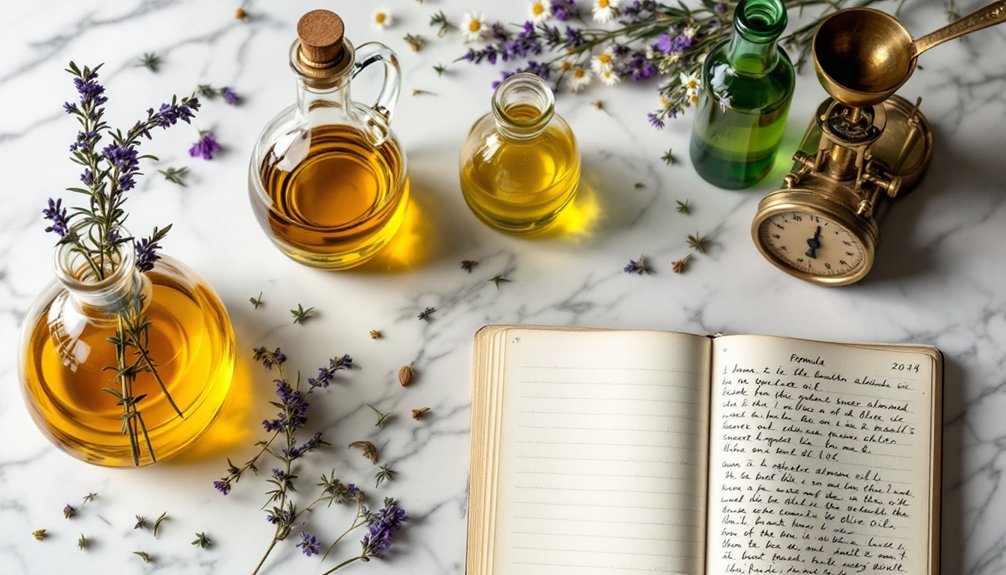



Leave a Reply